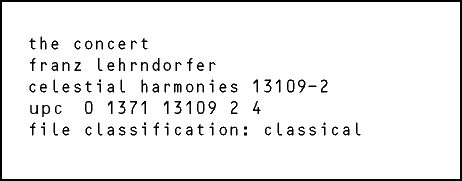 |
||||||||||||||||||||||||||||||||||||||||||||||||||||||||||||
 
Geboren 1928 in Salzburg als Sohn des Kemptener Chordirektors und Musikwissenschaftlers Dr. Lehrndorfer. Meisterklassendiplom im Fach Orgel (1952), gewann 1957 den ersten Preis des internationalen ARD-Musik-Wettbewerbs. Seit 1969 Domorganist der Münchner Frauenkirche, Leiter des Fachbereichs katholische Kirchenmusik und Orgel und Liturgie an der Münchner Musikhochschule (1969-1993). Weltberühmt durch seine Orgelkonzerte und hohe Kunst der Improvisation. 10. April 1994. 500-Jahrfeier der Münchner Frauenkirche, Einweihung der neuen großen Orgel (16 m hoch, 10 m breit), gebaut von Georg Jann. Viele Menschen finden keinen Platz mehr in der Kirche und lauschen von draußen dem Konzert von Prof. Franz Lehrndorfer, der zugleich sein 25. Jubiläum als Domorganist feiert. Auf dem Programm stehen Werke von Lully, Frescobaldi, Clérambault, J.S. Bach (Toccata d-moll), Liszt (Präludium und Fuge über B-A-C-H), Reger und Messiaen. Das unvergessliche Konzert schließt mit einer freien Improvisation von Lehrndorfer. the projectSunday, April 10, 1994, was a very special day in
the musical history of Munich, a city blessed with a rich and colorful
musical past. Late in the afternoon on a pleasant spring day, an unexpectedly
large audience of thousands assembled in the Dome at Munich, the Liebfrauendom
or Frauenkirche.
There were just too many people for the big church to hold, so the audience flowed through the open gates into the plaza surrounding the Dome. The church itself was so crowded that one could not even see the tiniest speck of the magnificent new marble floor. The mood resembled that of a pop concert more than that of a religious event, and the large audience seemed to indicate even to the most casual observer that a unique event was taking place. During the celebrations commemorating the 500th anniversary of the Dome, Franz Lehrndorfer celebrated his 25th anniversary as the Dome Organist, and what better way to celebrate these occasions than to inaugurate the new organ. The Dome, having been badly damaged during the last war, had undergone a large-scale restoration simultaneously with the installation of the new organ. Built by master craftsman Georg Jann and his team over a period of several years and at very considerable expense to the diocese, everyone had come to hear one of the finest musicians play one of the greatest instruments on Earth. For centuries the pipe organ had been called the queen of instruments, and this new organ could easily be the queen of organs. As tall as a five-story building with over 7,000 pipes and incorporating the most sophisticated electronic systems, there are few, if any, organs in existence which could match the sheer splendor of Munich's latest addition to its musical scene. Franz Lehrndorfer's program included a wide variety of music written for the organ over the centuries but most importantly, it featured Professor Lehrndorfer improvising in his own personal style, just as Bach might have done in his day. After the concert ended, there was a never-ending line of well-wishers. It took hours for the church and plaza to clear as darkness fell and the day came to an end. This recording features the exact program as was heard during the inaugural concert. However, due to tuning difficulties experienced as the new organ settled into its environment and due to the unavoidable distraction caused by audience noise, Franz Lehrndorfer and his engineer/producer and long-time friend Ulrich Kraus chose to rerecord the program in a silent church. Also in attendance at these recording sessions was the organ builder whose ever-present attention was required in order to retune pipes which had changed pitch due to temperature differences. After many days of experimenting, an ideal microphone placement was found; once the microphones were suspended at a height of almost 100 feet in the center of the large space, Ulrich Kraus was finally able to capture the grand sound of the organ to his satisfaction. the artistFranz Lehrndorfer was appointed organist of the Munich
Cathedral in 1969, the same year he became head of the Department
of Organ and Catholic Liturgical Music at the Munich Conservatory.
In 1957, he proved his mastery of the organ when he won first prize
at the international ARD Competition sponsored by the German broadcasting
network. His renown and the resulting demand for his services as a
teacher led him to found a School of Organ in Munich, which has since
produced two generations of graduates. More than a few names well-known
to the music world may be counted among them.
Lehrndorfer is a recognized master of the art of improvisation. His concerts both in Germany and abroad are invariably met with enthusiasm and admiration, and many of his performances have been preserved in recordings, including Celestial Christmas 5 (13090-2). His expert knowledge of the organ, accumulated over many years, allowed him to make an important contribution to the design of the new cathedral organ. As Dome Organist, Lehrndorfer has carried on a tradition of organ recitals initiated by his predecessors and has expanded their scope. Well-known contemporary composers write works for him to premiere. biographydiscographytracklist
|
||||||||||||||||||||||||||||||||||||||||||||||||||||||||||||
|
|
||||||||||||||||||||||||||||||||||||||||||||||||||||||||||||
 |


